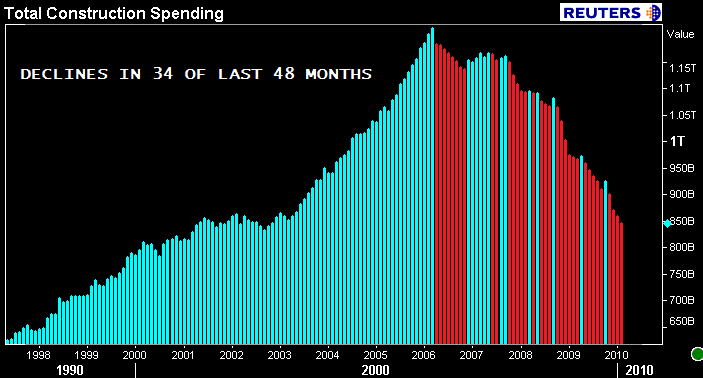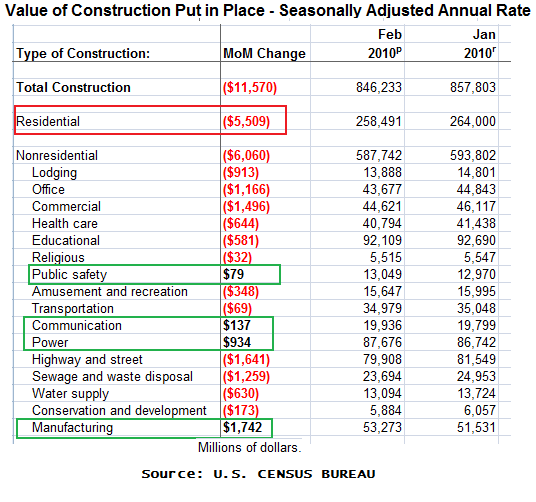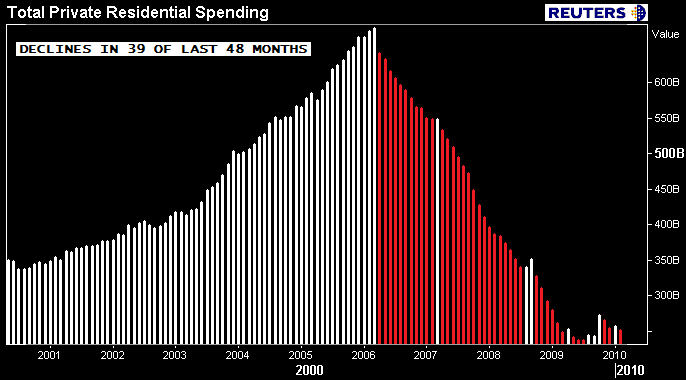Blog

Residential Construction Spending Continues to Decline. Is That a Good Thing?
Total construction spending fell for a fourth straight month inFebruary to the slowest pace since November 2002, according to New Construction Spending data released by the Commerce Department today.
Overall construction spending, which includes public and privateoutlays, fell 1.3 percent to a seasonally adjusted annualized rate of$846.2 billion. This follows a revised for the worse 1.4 percent declinern in January, originally reported as a 0.6 percent drop.
Total construction spending has fallen in 34 of the last 48 months.

The decline was broad based with only manufacturing seeing a healthy rebound in February. Contractions in commercial construction, office building, and highway spending led the way lower.

Private residential spending was at a seasonally adjusted annual rate of $258.5 billion in February. Residential real estate spending has declined in 39 of the last 48 months.

Some folks are starting to panic about a lack of momentum in certain forward looking indicators like Housing Starts and Building Permits.
Focusing on Housing Starts, Building Permits, and Residential Construction Spending doesn't seem to make much sense in today's housing market though. Isn't that putting the cart before the horse? Existing homes inventory rose 9.5 percent last month. Raw unsold inventory is up 5.5 percent from a year ago. This doesn't even include shadow inventory!
Plain and Simple: We don't need anymore housing inventory on the market. It's ok that new home sales and housing starts are failing to gain traction. We need housing demand to eat away at current inventory before homebuilder start adding supply. Once that occurs, relying on Housing Starts, Building Permits, and Residential Construction Spending will be a whole lot more relevant.
(Residential Construction Spending includes remodeling, additions, and major replacements to owner occupied properties subsequent to completion of original building. It includes construction of additional housing units in existing residential structures, finishing of basements and attics, modernization of kitchens, bathrooms, etc. Also included are improvements outside of residential structures, such as the addition of swimming pools and garages, and replacement of major equipment items such as water heaters, furnaces and central air-conditioners. Maintenance and repair work is not included. This doesn't tell us much about new home building but it should be noted.)
All Content Copyright © 2003 – 2009 Brown House Media, Inc. All Rights Reserved.nReproduction in any form without permission of MortgageNewsDaily.com is prohibited.
Latest Articles
By John Gittelsohn August 24, 2020, 4:00 AM PDT Some of the largest real estate investors are walking away from Read More...
Late-Stage Delinquencies are SurgingAug 21 2020, 11:59AM Like the report from Black Knight earlier today, the second quarter National Delinquency Survey from the Read More...
Published by the Federal Reserve Bank of San FranciscoIt was recently published by the Federal Reserve Bank of San Francisco, which is about as official as you can Read More...

Comments
Leave a Comment